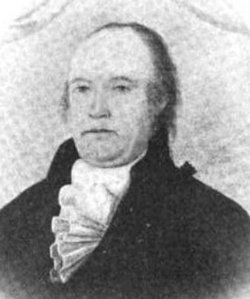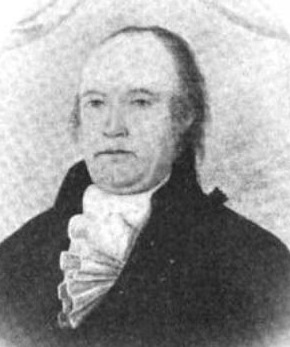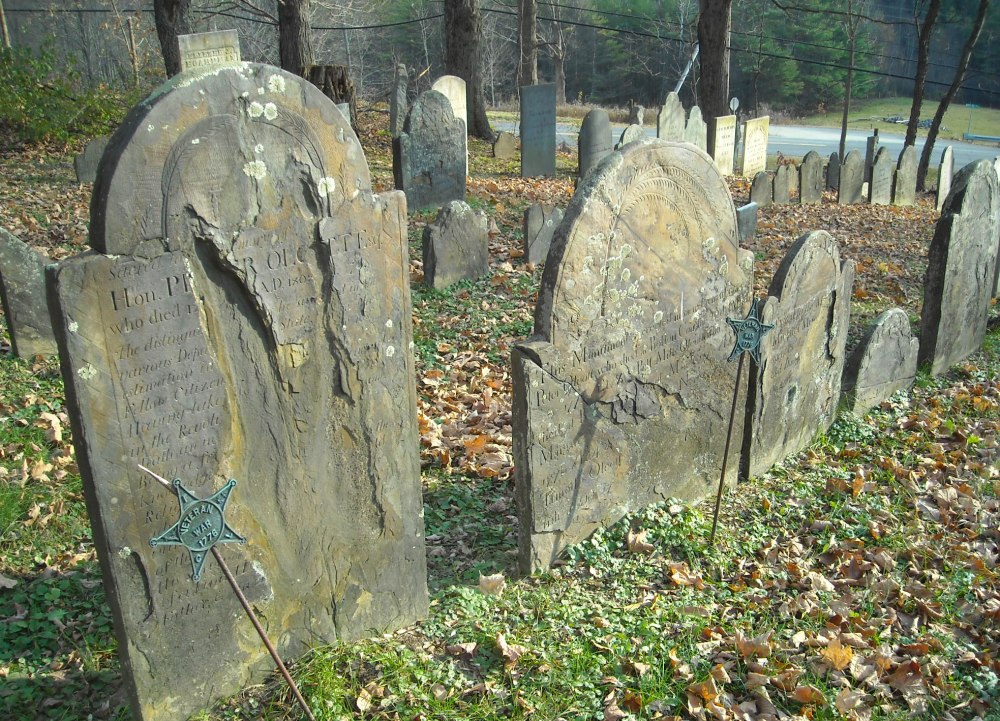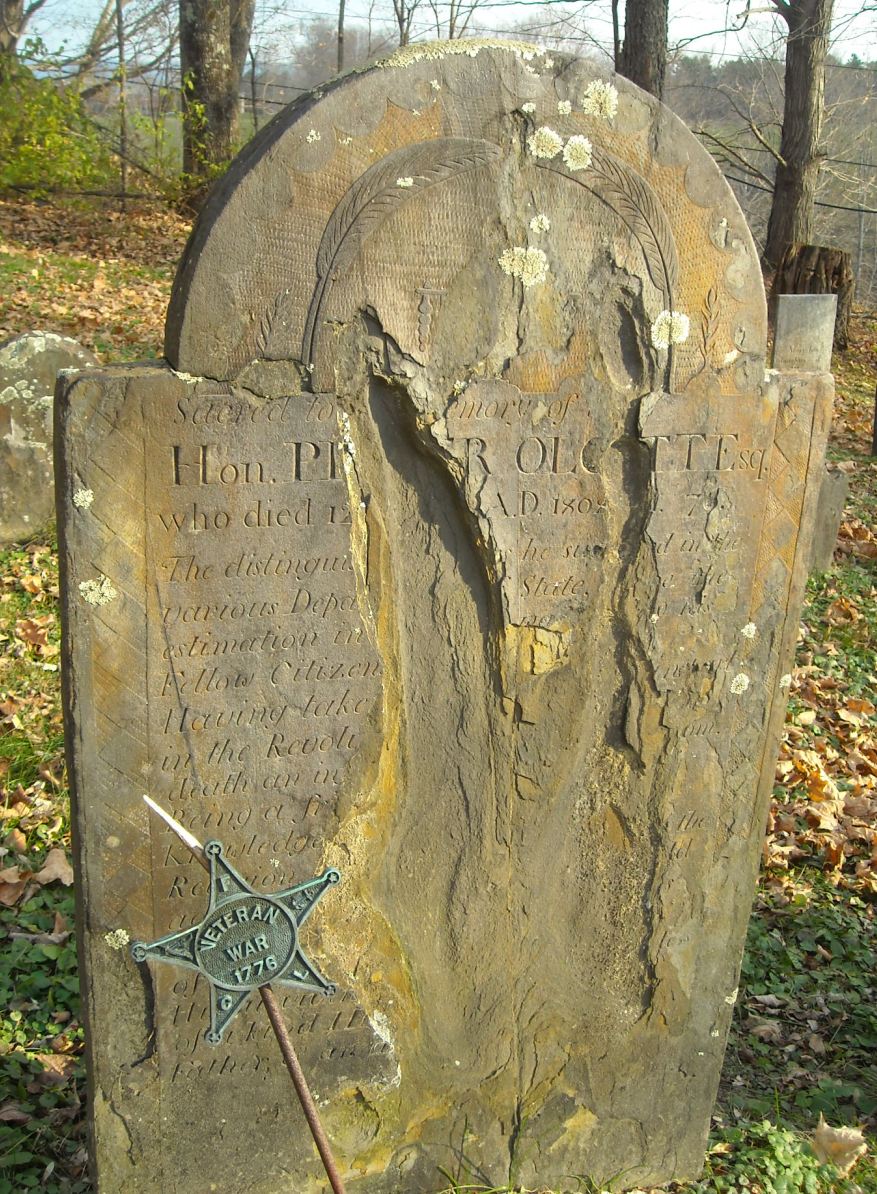Peter married, October 11, 1759 at Bolton, Tolland County, Connecticut Colony, Sarah Mills (1737-1810) by whom he had 9 children (5 sons and 3 daughters): Pell Mills (1762-1773), Peter (1764-1773), Timothy (1766-1799), Roswell (1768-1841), Sarah (1769-1788), Margaret, Margaret (1772-1796), Mills (1774-1845), and Martha (1776-1825).
Peter moved, with his family, from Bolton to Windsor, Connecticut in 1772 Later that year or the next he moved to Norwich, Gloucester County, Province of New York (later Windsor County, Vermont). There, he became one of the town's eminent men.
In 1773, He was chosen one of the Town's Overseers of the Poor at Norwich's March Annual Town Meeting. From 1774 until 1779, Norwich's Annual Town Meeting was held at his house. Peter was the first Justice of the Peace in the Town, being chosen to that office at a special town meeting called for that purpose, April 7, 1778. He was a Town Selectman (Supervisor) during the years 1774, 1775, 1777 and 1778. In 1776, he was Norwich's Town Clerk.
A Company of Militia was organized in Norwich as early as the year 1774 or 1775. Peter commanded this Company as its Captain. In 1775, the militia of the county was organized into a Regiment Peter was chosen the Regiment's Colonel. Throughout the Revolutionary War, Colonel Olcotts' Companies and elements thereof, at his direction, were engaged in responding to various alarms, scouting, and defending the Towns on the Vermont Frontier. On August 11, 1777, the Vermont Council of Safety , meeting at Bennington, Bennington County, Vermont sent an express, via Brigadier General Bailey, to Colonel Olcott for one half of his Militia to march for the relief of Bennington, but, for the want of time this did not happen and they were employed in other military service. On September 18, 1777, the Vermont Council of Safety directed Colonel Olcott to immediately march his Regiment of Militia to join General Gates then a Saratoga. They were at the capitulation of British General Burgoyne and his Army in October, 1777. On April 12, 1781, Colonel Olcott was chosen to Command the 3rd Vermont Militia Brigade with the rank of Brigadier General. He continued in that capacity to 1788.
He served as a Commissioner of confiscated Tory Property in 1777 under Province of New York authority. In 1778, he held the same office under Vermont. At the Conventions held at Windsor, June, July and December, 1777, he was a member representing the Town of Norwich. At the said convention in June, he signed the "revised declaration" (Vermont's New Constitution).
In March 1778, Peter was elected one of two Norwich Town's Representatives to the Vermont General Assembly, but on the convening of the legislature it was found that he had been chosen to be a member of its Council. He accordingly took his seat in that body and served therein until October, 1779 and again 1781-1790. In 1781, he was Judge of the Windsor County Court. From 1782-1785, he was a Judge of the Vermont Supreme Court. He was Vermont's Lieutenant Governor, 1790 -1794. He returned to serve in the Vermont General Assembly, in 1801, as one of Norwich's Town Representatives.
Peter was a Trustee of Dartmouth College, in Hanover, Grafton County, New Hampshire, from 1788 until his death. He died at the house of his son, Mills Olcott, Esq. in Hanover, September 12, 1808, aged 75 years.
References:
(1) "The Descendants of Thomas Olcott, One of the First Settlers of Hartford, Ct." by Nathaniel Goodwin, 1874, pages 20, 39, 52-53 and 69-70.
(2) "Vital Records of Bolton to 1854 and Vernon to 1851" by the Connecticut Historical Society, 1909, pages 13, 18, 26, 49 and 71.
(3) "History of Windsor County Vermont with Illustrations and Biographical Sketches of some of its Prominent Men and Pioneers" by Lewis Cass Aldrich and Frank R. Holmes, 1891, pages 480, 481 and 484.
(4) "A History of Norwich Vermont (Published by the Authority of the Town) with Portraits and Illustrations" by M. E. Goddard and Henry V. Partridge, 1905, pages 84-86, 89, 229-231, 264-265, and 269-271.
(5) "The State of Vermont - Rolls of the Soldiers in the Revolutionary War 1775 to 1783" by John E. Goodrich, 1904, pages 11, 52, 53, 55, 113, 147, 190, 257, 281, 294, 295, 311, 349, 350, 356, 360, 368, 371, 433, 441, 442, 443, 627, 651, 726, 773, 780, 781, 784, 785, and 810.
(6) "Records of the Council of Safety and Governor and Council of the State of Vermont to which are prefixed the Records of the General Conventions from July 1775 to December 1777." Vol. I., by E. P. Walton, 1873, pages 54, 55, 138, 171, 189, 200, 207, 214, 234, 235, 241, 243, 249, 257, 273, 275, 305, 307, 374, 436, and 527.
Peter married, October 11, 1759 at Bolton, Tolland County, Connecticut Colony, Sarah Mills (1737-1810) by whom he had 9 children (5 sons and 3 daughters): Pell Mills (1762-1773), Peter (1764-1773), Timothy (1766-1799), Roswell (1768-1841), Sarah (1769-1788), Margaret, Margaret (1772-1796), Mills (1774-1845), and Martha (1776-1825).
Peter moved, with his family, from Bolton to Windsor, Connecticut in 1772 Later that year or the next he moved to Norwich, Gloucester County, Province of New York (later Windsor County, Vermont). There, he became one of the town's eminent men.
In 1773, He was chosen one of the Town's Overseers of the Poor at Norwich's March Annual Town Meeting. From 1774 until 1779, Norwich's Annual Town Meeting was held at his house. Peter was the first Justice of the Peace in the Town, being chosen to that office at a special town meeting called for that purpose, April 7, 1778. He was a Town Selectman (Supervisor) during the years 1774, 1775, 1777 and 1778. In 1776, he was Norwich's Town Clerk.
A Company of Militia was organized in Norwich as early as the year 1774 or 1775. Peter commanded this Company as its Captain. In 1775, the militia of the county was organized into a Regiment Peter was chosen the Regiment's Colonel. Throughout the Revolutionary War, Colonel Olcotts' Companies and elements thereof, at his direction, were engaged in responding to various alarms, scouting, and defending the Towns on the Vermont Frontier. On August 11, 1777, the Vermont Council of Safety , meeting at Bennington, Bennington County, Vermont sent an express, via Brigadier General Bailey, to Colonel Olcott for one half of his Militia to march for the relief of Bennington, but, for the want of time this did not happen and they were employed in other military service. On September 18, 1777, the Vermont Council of Safety directed Colonel Olcott to immediately march his Regiment of Militia to join General Gates then a Saratoga. They were at the capitulation of British General Burgoyne and his Army in October, 1777. On April 12, 1781, Colonel Olcott was chosen to Command the 3rd Vermont Militia Brigade with the rank of Brigadier General. He continued in that capacity to 1788.
He served as a Commissioner of confiscated Tory Property in 1777 under Province of New York authority. In 1778, he held the same office under Vermont. At the Conventions held at Windsor, June, July and December, 1777, he was a member representing the Town of Norwich. At the said convention in June, he signed the "revised declaration" (Vermont's New Constitution).
In March 1778, Peter was elected one of two Norwich Town's Representatives to the Vermont General Assembly, but on the convening of the legislature it was found that he had been chosen to be a member of its Council. He accordingly took his seat in that body and served therein until October, 1779 and again 1781-1790. In 1781, he was Judge of the Windsor County Court. From 1782-1785, he was a Judge of the Vermont Supreme Court. He was Vermont's Lieutenant Governor, 1790 -1794. He returned to serve in the Vermont General Assembly, in 1801, as one of Norwich's Town Representatives.
Peter was a Trustee of Dartmouth College, in Hanover, Grafton County, New Hampshire, from 1788 until his death. He died at the house of his son, Mills Olcott, Esq. in Hanover, September 12, 1808, aged 75 years.
References:
(1) "The Descendants of Thomas Olcott, One of the First Settlers of Hartford, Ct." by Nathaniel Goodwin, 1874, pages 20, 39, 52-53 and 69-70.
(2) "Vital Records of Bolton to 1854 and Vernon to 1851" by the Connecticut Historical Society, 1909, pages 13, 18, 26, 49 and 71.
(3) "History of Windsor County Vermont with Illustrations and Biographical Sketches of some of its Prominent Men and Pioneers" by Lewis Cass Aldrich and Frank R. Holmes, 1891, pages 480, 481 and 484.
(4) "A History of Norwich Vermont (Published by the Authority of the Town) with Portraits and Illustrations" by M. E. Goddard and Henry V. Partridge, 1905, pages 84-86, 89, 229-231, 264-265, and 269-271.
(5) "The State of Vermont - Rolls of the Soldiers in the Revolutionary War 1775 to 1783" by John E. Goodrich, 1904, pages 11, 52, 53, 55, 113, 147, 190, 257, 281, 294, 295, 311, 349, 350, 356, 360, 368, 371, 433, 441, 442, 443, 627, 651, 726, 773, 780, 781, 784, 785, and 810.
(6) "Records of the Council of Safety and Governor and Council of the State of Vermont to which are prefixed the Records of the General Conventions from July 1775 to December 1777." Vol. I., by E. P. Walton, 1873, pages 54, 55, 138, 171, 189, 200, 207, 214, 234, 235, 241, 243, 249, 257, 273, 275, 305, 307, 374, 436, and 527.
Family Members
-
![]()
Pelletiah Mills Olcott
1763–1773
-
![]()
Pelatiah Mills Olcott
1763–1773
-
![]()
Peter Olcott
1764–1773
-
![]()
Timothy Olcott
1766–1799
-
![]()
Gen Roswell Olcott
1768–1841
-
![]()
Sarah "Sally" Olcott Murdock
1769–1788
-
![]()
Margaret Olcott
1772–1776
-
![]()
Mills Pelatiah Olcott
1774–1845
-
![]()
Martha Olcott Porter
1776–1825
-
![]()
Margaret Olcott Murdock
1777–1796
Advertisement
Advertisement


















